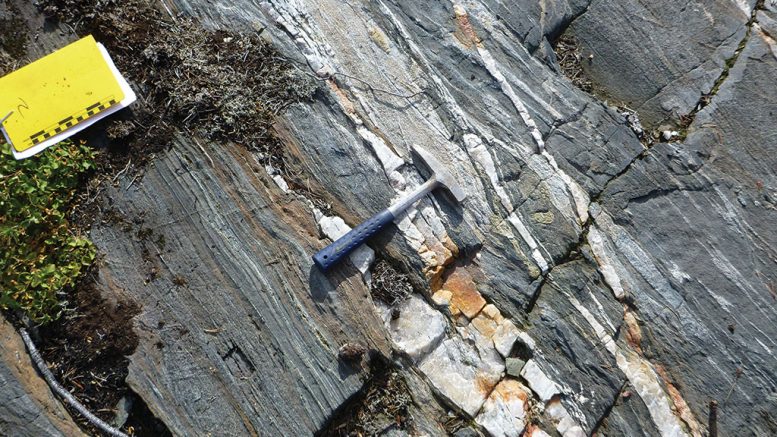
In May 2016, Silver Standard Resources, now called SSR Mining (TSX: SSRM; NASDAQ: SSRM), acquired Claude Resources and its Seabee gold operation in Saskatchewan for $337 million in cash and shares.
Five months later, SSR Mining optioned Taiga Gold’s (CNSX: TGC) Fisher project — whose property boundary lies 1.5 km south of Seabee’s Santoy mine.
The Santoy mine is hosted by the Santoy shear, a regional, north-trending shear zone that has been traced over much of the Fisher property.
“It’s an important structure, and that’s where the focus of much exploration has been for the last several years,” says Mike Labach, Taiga Gold’s head of investor relations.
Fisher and SSR Mining’s Seabee complex, 125 km northeast of La Ronge, are within the Pine Lake Greenstone belt and located along eastern Saskatchewan’s Tabbernor fault structure.
Results from SSR Mining’s 7,640-metre drill program this year included visible gold over a 7-metre interval at the Mac target. Drill hole 19-035 returned 13.72 grams gold per tonne over 1 metre from 366 metres downhole and 7.15 grams gold over 2 metres.
“Hole 35 represented the first occurrence of a mineable width at above cut-off grade mineralization,” Labach says.
Other results included drill hole 19-030, which assayed 6.8 grams gold over 2 metres from 139 metres, and 19-029, which cut 1.43 grams gold over 3 metres from 511 metres, and 1.80 grams over 2 metres from 528 metres.
SSR Mining also collected 5,000 to 6,000 soil samples in the third quarter. The extensive geochemical sampling and prospecting program targeted three high-priority areas — the Mac (Santoy shear) target, and the DD and Footprint targets.
“That might not sound too terribly important to investors because they want to see drill results, but those soils cover a huge area,” Labach says. “That’s a very large program that should drive some interesting results, and perhaps generate more drill targets. On top of that, they focused prospecting along the shear zone.”
Labach notes that the promising intercept in drill hole 35 was north of the Mac zone on the Santoy shear. “Mac is central to the Fisher property, and the shear zone goes through that area, it changes direction in the area of the Mac, and that’s what you want, a flexure, possibly creating a void that mineralizing fluids could have exploited.”
Labach adds that the area around the Mac appears to be analogous to the Santoy mine, saying that “the type of mineralization, the nature of the shear zone itself, the lithology, the stratigraphy, alteration — it’s similar to that of Santoy.”
Under the option deal, SSR Mining paid $100,000 in cash up-front and agreed to spend at least $4 million on exploration over four years, in addition to annual cash payments of $75,000 over the option period.
Once it completes the earn-in, SSR Mining has one year to decide whether it wants to earn another 20% in the project by making a $3-million cash payment, at which point SSR Mining would own 80% of Fisher, and Taiga the rest.
SSR Mining has already spent $6.7 million on Fisher, thereby satisfying the exploration spending requirement under the option agreement.
“They have been systematically testing the shear zone area in a number of locations, looking for small, high-grade gold deposits,” Labach says. “It appears that they have the ability and motivation to locate more ounces for that big investment they made in Claude Resources and the Seabee gold operation.”
Taiga Gold was spun out of prospect generator Eagle Plains Resources (TSXV: EPL) in April 2018. Eagle Plains picked up the Fisher property in 2012, long before SSR Mining acquired Claude Resources.
One of Eagle Plains’ biggest success stories was its acquisition of the Copper Canyon property in northwestern B.C. for $10,000. It spun out the asset, which is located next to NovaGold Resources’ (TSX: NG; NYSE-AM: NG) Galore Creek project, and sold it to NovaGold in 2011 for $65 million.
“During the latest downturn we tasked our chief geologist with targeting the best properties for gold in western Canada,” says Labach, who also heads up the IR department for Eagle Plains. “Eagle Plains maintains a healthy treasury, and our business model is to take advantage of downturns by leveraging that treasury to acquire good projects when nobody else wants them, or there’s very little interest in the area — that’s the time we make hay. As a result, we’ve made some really great acquisitions. We then assess them, package them, and sell them when times are better.”
The plan is to do it again with Taiga Gold’s Fisher project.
“It’s very unlikely we could have in the good times acquired that type of land package adjacent to an operating mine,” Labach says. “Management and our technical team did a great job putting it together and having the foresight to do so.
(This article first appeared in the November 11-24, 2019 edition of The Northern Miner)